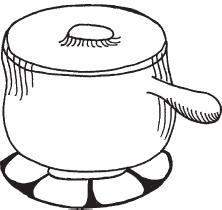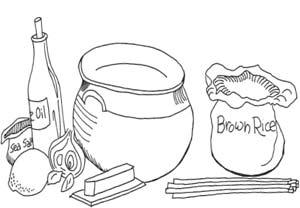Nourishing Traditions: The Cookbook That Challenges Politically Correct Nutrition and The... (129 page)
Authors: Sally Fallon,Pat Connolly,Phd. Mary G. Enig
Tags: #Non-Fiction, #Reference, #Science, #Health
Nevertheless, whole rice in moderation has a place in most diets. As rice contains no gluten, a difficult-to-digest protein found in wheat, oats, rye and barley, it is often well tolerated by those with grain allergies. It is relatively low in phytic acid and so does not necessarily require overnight soaking before preparation. A long, slow steaming in mineral-rich broth is sufficient to neutralize most of the phytic acid content and results in a preparation that some people find more palatable than rice that has been soaked overnight.
Brown rice is highest of all grains in B vitamins and also contains iron, vitamin E and some protein.
Short grain rice is starchier and stickier than long grain rice. Basmati rice grown in the Himalayas, wehini rice grown in California and texmati rice grown in Texas are all noted for their rich flavor and aroma.
What about the accusation that "all brown rice is rancid?" Tests indicate that airtight packaging will protect rice from developing free radicals and off flavors. So buy brown rice in airtight containers or packages, not loose rice from bins. SWF

BASIC BROWN RICE I
(Unsoaked Rice)
Serves 6-8
2 cups long-grain brown rice
2 tablespoons butter
2 tablespoons extra virgin olive oil
3 cardamom pods
4 cups
chicken stock
or combination of filtered water and chicken stock1 tablespoon gelatin (See
Sources
), optional½ teaspoon sea salt
In a heavy, flameproof casserole, melt butter and olive oil. Open cardamom pods and add seeds to the casserole. Saute rice in butter and oil, stirring constantly, until rice begins to turn milky. Pour in liquid, add salt and optional gelatin and bring to a rolling boil. Boil, uncovered, for about 10 minutes until water has reduced to the level of the rice. Reduce flame to lowest heat, cover tightly and cook for at least 1½ hours or as long as 3 hours. Do not remove lid during cooking.
Variation: Brown Rice and Bulgur
Use
1 cup long-grain brown rice
and
1 cup
bulgur
in place of 2 cups long-grain rice.
Variation: Basic Wehini or Texmati Rice
Use
2 cups wehini or texmati rice
in place of long-grained rice.
Variation: Coconut Rice
Use
1-2 cups
coconut milk
, or
7 ounces creamed coconut (see
About Coconut Products
), melted
, as part of the 4 cups of liquid.
Variation: Liver and Rice
Add
2-3 ounces liver, grated or finely chopped
, to the rice as it cooks.
During the building of the great wall of China, coolies were fed salted [fermented] cabbage with their rice to keep them strong and healthy. Salting [fermenting] preserved the cabbage in season and out, and it was the only vegetable they had to supplement their complete, unrefined rice. When the Mongols overran China, knowing a good thing when they tried it, they adopted salted [fermented] cabbage as a very practical traveling ration. The Mongol armies got as far as Hungary in the thirteenth century, where they introduced salted cabbage to Europe. As sauerkraut, it became one of the principal foods of Germany and eastern Europe.
Julius Caesar's legions, the most efficient fighting machine the world had ever known, ranged far from Rome. The sole provisions were sacks of grain—one for each man. Like the Viet Cong, Caesar's men did not have sugar or kitchens, nor did they have a medical corps, only surgeons for repairing wounds. They ate whole grains plain, on the march, or ground into Roman meal and supplemented with cabbage and any other vegetables they could scrounge. Pliny has said that cabbage kept Rome out of the hands of physicians for many centuries. It was the European armies traveling in the other direction that ran into trouble. In his history of the invasion of sugar-rich Egypt by the Crusaders of St. Louis in 1260, Sire Jean de Joinville described the funguous putrid bleeding gums, the hemorrhaging skin spots, and the swollen legs that plagued Christian armies and led to the ultimate defeat and capture of the holy knights and their commander. William Dufty
Sugar Blues

BASIC BROWN RICE II
(Soaked Rice)
Serves 6-8
2 cups long-grain or short-grain brown rice
4 cups warm filtered water plus 4 tablespoons
whey
,
yoghurt
,
kefir
or
buttermilk1 teaspoon sea salt
2-4 tablespoons butter
Place rice and warm water mixture in a flameproof casserole and leave in a warm place for at least 7 hours. (Note: Those with severe milk allergies can use
lemon juice or vinegar
in place of whey, yoghurt, kefir or buttermilk.) Bring to a boil, skim, reduce heat, stir in salt and butter and cover tightly. Without removing lid, cook over lowest possible heat for about 45 minutes.
At the beginning of World War II. . .. the British medical officer of Singapore, Dr. Scharff, made the same kind of hard decision that had saved Denmark in World War I during the German blockade. Polished white rice was forbidden by military decree. Only unpolished brown rice could be sold. British military authorities were influenced by one factor only: Inadequate supplies. They were worried about quantity; quality was of no concern. They simply didn't want any food riots on their hands. . .the aftermath was startling, incredible. Dr. Scharff had originally gone to Singapore with the mission of reducing infant mortality from malaria. When he arrived, the mortality rate was 420 per 1,000 births. He used herculean but orthodox medical methods. In less than a decade, the program had reduced the death rate of infants to 160 per 1,000, almost on a par with the existing rate in Britain. However, after a year on the brown rice diet enforced by military decree, there was a dramatic shift in vital statistics. Instead of 160 infants dying in their first year of life, only 80 died. The figure was cut in half without medical efforts. William Dufty
Sugar Blues
BROWN RICE PILAF
Serves 6-8
1½ cups long-grain brown rice
1 cup buckwheat or brown rice noodles, broken into 1-inch bits
1 medium onion, finely chopped
2 cardamom pods
1 teaspoon dried thyme or dill
grated rind of 1 lemon (optional)
2 tablespoons butter
2 tablespoons extra virgin olive oil
4 cups
chicken stock
or combination of filtered water and stock1 tablespoon gelatin (See
Sources
), optional½ teaspoon sea salt
In a heavy, flameproof casserole, melt butter and olive oil. Open cardamom pods and add seeds to the casserole. Add onion and thyme or dill and optional lemon rind and saute until onion is soft. Add noodles and saute, stirring, until they turn brown. Add rice and saute, stirring, until rice turns milky. Pour in liquid, add salt and optional gelatin and lemon rind and bring to a rolling boil. Boil, uncovered, for about 10 to 15 minutes until the water has reduced to the level of the rice. Reduce flame to lowest heat, cover tightly and cook for at least 2 hours or as long as 3 hours. Do not remove lid during cooking.
In 1960, researchers at Ann Arbor University performed an interesting experiment on laboratory rats. Eighteen rats were divided into three groups. One group received cornflakes and water; a second group was given the cardboard box that the cornflakes came in and water; and the control group received rat chow and water. The rats in the control group remained in good health throughout the experiment. The rats receiving the box became lethargic and eventually died of malnutrition. But the rats receiving cornflakes and water died before the rats who were given the box—the last cornflake rat died on the day the first box rat died. Before death the cornflake rats developed schizophrenic behavior, threw fits, bit each other and finally went into convulsions. Autopsy revealed dysfunction of the pancreas, liver and kidneys and degeneration of the nerves in the spine—all signs of "insulin shock." The startling conclusion of this study is that there is more nourishment in the box that cold breakfast cereals come in than in the cereals themselves. Loren Zanier, designer of the experiment, actually proposed the protocol as a joke. But the results are far from funny. They were never published and similar studies have not been repeated. If consumers knew the truth about breakfast cereals, vast fortunes would be jeopardized. SWF

RICE AND CARROT CASSEROLE
Serves 6-8
2 cups long-grain brown rice
2 tablespoons butter
2 tablespoons extra virgin olive oil
1 medium onion, finely chopped
1 teaspoon dried thyme
4 whole cloves
3 cardamom pods
grated rind of 1 lemon (optional)
4 cups
chicken stock
or combination of filtered water and stock1 tablespoon gelatin (See
Sources
), optional½ teaspoon sea salt
1 cup grated carrots
½ cup raisins